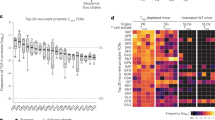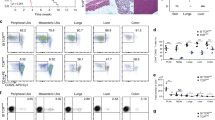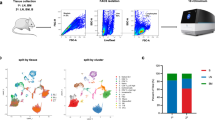Abstract
Leprosy is a chronic infectious disease caused by Mycobacterium leprae. A characteristic feature of the disease is its remarkable spectrum of clinical symptoms correlating with the cellular immune responsiveness of the patient1. At one pole of this spectrum are tuberculoid patients displaying both acquired cell-mediated immunity and delayed type hypersensitivity against the bacillus2–4.At the other pole are lepromatous patients which show a specific T-cell unresponsiveneess against M.leprae5. In between those two poles variable degrees of tuberculoid and lepromatous features may be seen in borderline leprosy patients. Thus far, studies on the mechanism of the antigen specific unresponsiveness in lepromatous leprosy have been contradictory and difficult to interpret, probably because of the use of heterogeneous cell populations in those experiments6–10. We have now succeeded in cloning M. leprae stimulated T-helper (TH) as well as T-suppressor (Ts) cells from a borderline lepromatous patient. The Ts-clones of this patient specifically suppress reponses of peripheral TH cells as well as TH clones induced by both M. leprae and other mycobacteria, but not unrelated antigen or mitogen. These Ts cells also completely suppress TH cell responses against aM. leprae specific protein with a relative molecular mass of 36,000 (36K), suggesting the presence of a suppression inducing determinant on this 36K M. leprae protein.
This is a preview of subscription content, access via your institution
Access options
Subscribe to this journal
Receive 51 print issues and online access
$199.00 per year
only $3.90 per issue
Buy this article
- Purchase on Springer Link
- Instant access to full article PDF
Prices may be subject to local taxes which are calculated during checkout
Similar content being viewed by others
References
Bloom, B. R. & Godal, T. Rev. infect. Dis. 5, 765–780 (1983).
Rees, R. J. W. Nature 211, 576 (1966).
Patel, P. J. & Lefford, M. J. Infect. Immun. 19, 87–93 (1978).
Lowe, C., Brett, S. J. & Rees, R. J. W. Clin. exp. Immun. 61, 336–342 (1985).
Bloom, B. R. & Mehra, V. Immun. Rev. 80, 5–28 (1984).
Mehra, V., Mason, L. H., Fields, J. P. & Bloom, B. R. J. Immun. 123, 1813–1817 (1979).
Mehra, V., Brennan, P. J., Rada, E., Convit, J. & Bloom, B. R. Nature 308, 194–196 (1984).
Nath, I., van Rood, J. J., Mehra, N.K. & Vaidya, M. C. Clin. exp. Immun. 42, 203–210 (1980).
Sathish, M., Bhutani, L. K., Sharma, A. K. & Nath, I. Infect. Immun. 42, 890–899 (1983).
Salgame, P. R., Mahadevan, P. R. & Antia, N.H. Infect. Immun. 40, 1119–1126 (1983).
Blue, M. L., Daley, J. F., Levine, H. & Schlossman, S. F. J. Immun. 134, 2281–2286 (1985).
Farcet, J. P. et al. Eur. J. Immun. 15, 1067–1073 (1985).
Young, R. A. et al. Nature 316, 450–452 (1985).
Klatser, P. R., de Wit, M. Y. L. & Kolk, A. J. H. Clin. exp. Immun. 62, 468–473 (1985).
Engers, H. D. et al. Infect. Immun. 48, 603–605 (1985).
Ottenhoff, T. H. M. et al. Nature 319, 66–68 (1986).
Wicker, L. S., Katz, M., Sercarz, E. & Miller, A. Eur. J. Immun. 14, 442–447 (1984).
Goodman, J. W. & Sercarz, E. A Rev.Immun. 1, 465–498 (1983).
Lehner, T., Mehlert, A., Avery, J., Jones, T. & Caldwell, J. J. Immun. 135, 1437–1442 (1985).
Oki, A. & Sercarz, E. J. exp. Med. 161, 897–911 (1985).
Krzych, U., Fowler, A. V. & Sercarz, E. J. exp. Med. 162, 311–323 (1985).
Mitchison, N. A. Nature 308, 112–113 (1984).
Bensussan, A., Acuto, O., Hussey, R. E., Milanese, C. & Reinherz, E. L. Nature 311, 565–567 (1984).
Mustafa, A. S. et al. Nature 319, 63–66 (1986).
Reitan, L. J., Closs, O. & Belehu, A. Int. J. Lepr. 50, 455–467 (1982).
Godal, T., Myklestad, B., Samuel, D. R. & Myrvang, B. Clin. exp. Immun. 9, 825–831 (1971).
Smelt, A. H. M., Rees, R. J. W. & Liew, F. Y. Clin. exp. Immun. 44, 507–511 (1981).
Stanford, J. L., Nye, P. M., Rook, G. A. W., Samuel, N. M. & Fairbank, A. A. Lepr. Rev. 52, 321–327 (1981).
Modlin, R. L. et al. Nature (in the press).
Ottenhoff, T. H. M., Elferink, B. G., Hermans, J. & de Vries, R. R. P. Human Immun. 13, 105–116 (1985).
Elferink, B. G., Ottenhoff, T. H. M. & de Vries, R. R. P. Scand. J. Immun. 22, 585–589 (1985).
Haanen, J. B. A. G. et al. Scand. J. Immun. 23, 101–108 (1986).
Author information
Authors and Affiliations
Rights and permissions
About this article
Cite this article
Ottenhoff, T., Elferink, D., Klatser, P. et al. Cloned suppressor T cells from a lepromatous leprosy patient suppress Mycobacterium leprae reactive helper T cells. Nature 322, 462–464 (1986). https://doi.org/10.1038/322462a0
Received:
Accepted:
Issue Date:
DOI: https://doi.org/10.1038/322462a0
This article is cited by
-
Identification of a Mycobacterium leprae‐specific T cell epitope on the 70 kDa heat shock protein
Immunology & Cell Biology (1994)
-
Limiting dilution analysis in leprosy
Immunology & Cell Biology (1992)
-
Rat Schwann cells can be induced to express major histocompatibility complex class II moleculesin vivo
Journal of Neurocytology (1992)
Comments
By submitting a comment you agree to abide by our Terms and Community Guidelines. If you find something abusive or that does not comply with our terms or guidelines please flag it as inappropriate.



